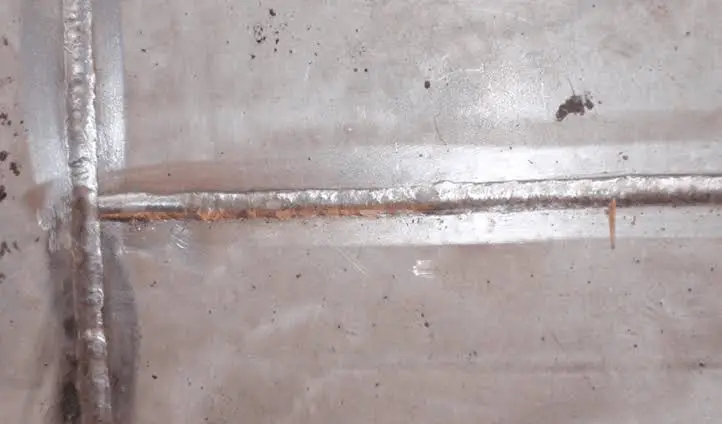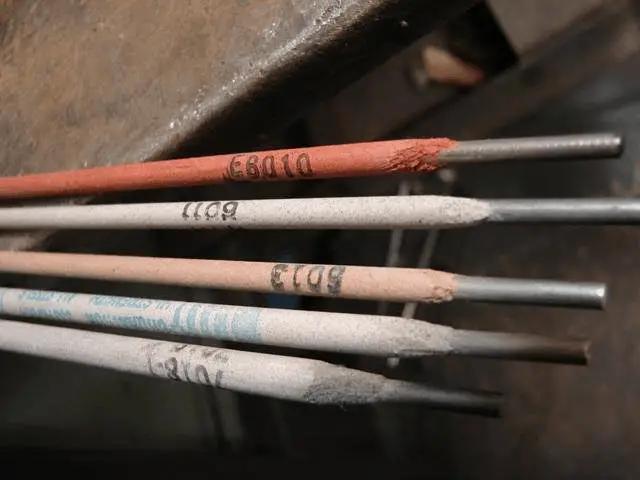Choosing the right welding rod is something troubles many welders. When it comes to welding rusty metal then preparation is key. You can start off with some grinding with steel wire before you can select the right wire. Some welders have suggested that flux core welding does a better job of going through the rusty wire than the MIG. Preparation will determine how good the metallic surface is ready for welding. In this article we check out some MIG wires you can use for rusty metal. The most common electrodes for MIG are 6010, 6011, 6013 and 7018.
ER70S-6 for rusty metal
The ER70S-6 MIG is a great wire for welding sheets with a moderate amount of rust or scale. The wire comes with higher amounts of deoxidizers. During welding you will need to mix your shielding gas with 98% argon/carbon dioxide and 2% oxygen. It has a tensile strength of 78,000 PSI and yield strength of 65,000 PSI. When you doing the welding push the gun a bit slower while letting the molten bead flow onwards.
Right Electrode for rusty metal
6010 and 6011 electrodes are very similar in nature as they are both fast freeze rods. What this means is that when welding you will notice that the weld puddle turns into solid from liquid very fast. The electrodes also offer welders deeper penetration hence making them ideal for rippled and flat bead while leaving very little slag. You can use the 6010 and 6011 for pipeliners, pipefitters and boilermakers.
Before you can identify the right welding rod electrode it is vital you learn about the various classifications. The first two numbers are the most important and stand for tensile strength. In our case the 60 means it can withstand 60,000 pounds per square inch. What this means is if you have an electrode with higher numbers the better. The “1” is the position in which you can use the welding rod. The last number is a classification that denotes individual electrode coatings. In our case the “10” means that the rode contains high content of cellulose sodium coating. The drawback is you can only use it with DC current. The 6010 can be used for a variety of applications but you cannot use it with an AC welding machine.
While the 6010 is a very common electrode by welders it is not very easy to use. This poses challenges to beginner welders as they try to grip the electrode as it produces a very tight arc.
The reason we have it in our list is because it offers deep penetration to the welds hence helping in cutting through rusty or corroded metal. The slag is also easy to chip off hence making it ideal for root passes on pipes. During welding you need to be extremely careful to avoid the electrode becoming drenched in by moisture.
There is little difference between this and the 6010. However, the last two digits mean it has a high content of cellulose potassium coating. This makes it ideal for both AC and DC currents. The 6010 runs on DCEP while the 6011 on current electrode positive (DCEP). When it comes to performance the 6011 chips better than the 6010 hence making it ideal for root passes in pipes. The 6011 burns at a higher speed than the 7018 hence making it ideal for bridging and welding joists. In cases where you do not need a lot of penetration like running downhill passes then the 6011 is ideal.
7018 electrode
This electrode offers the most versatility. It is used in most structural welding due to its smoothness and ease of use. The chemical combustion of the electrode does not have hydrogen. This makes it ideal for factories, shopping centers, nuclear weapons and bridges.
Flux core wire welding – Rusty metal

MIG welding may not be the best way for welding rust metal, flux core wire welding does better. In this method of self-shielded flux core welding an electrode is continuously fed through the welding gun and into the joint. The difference between this and MIG welding is you do not require shielding gas like argon or carbon dioxide to protect the weld from outside contamination. What happens is the flux electrode releases shielding gas whenever it is exposed to heat. This protects the weld from contamination. The positive is you can use the flux core wire welding technique outside as there is not shielding gas to be blown by the wind.
Flux core wire welding is better used for metals that are corroded or rusty. The welds have slag that is visible on the finished weld which makes it less attractive than the MIG weld.
MIG wire selection
If you are working on steel then they are two most commonly used wires in MIG welding. The ER70S-3 is the one that is all purpose and ideal for a variety of metal types, the ER70S-6 contains more deoxidizers hence making it ideal for rusty or dirty steel. For most home applications you will need to use a diameter of 0.030 inches while for thinner metal the ideal diameter is 0.023 inches. If you have thicker metals then go for diameters of 0.035 to 0.045 inches.
When welding you also need to factor in the shielding gas composition. Typically, most welding applications will require one to have 75% argon and 25% carbon dioxide. If you want a more tougher bead then go for 100% carbon dioxide.
Welding with MIG wire
When welding there are some things you need to consider for you to get the perfect weld. One you have to watch out for the shielding gas. This is the gas that prevents your weld from contaminants. Most of the MIG wires will have some level of deoxidizers added to keep them from excess oxygen. This is dangerous as when it forms combines with carbon from the metal forms carbon monoxide. In most cases you will have the manufacturers use Silicon, Manganese, Aluminum, Zirconium and titanium. If you are looking for the best deoxidizer wire go for the one with Zirconium, Titanium or Aluminum. Porosity affects good fusion of the metal and can lead to cracking of the weld as the CO gets trapped into the weld. In MIG welding the shielding gas is part of the welding gun. In most cases welders will use a combination of argon with carbon dioxide in the ration of 75% to 25%.
Preparation of the weld
In most cases, you need to carefully prepare the metallic surfaces before you can start welding. MIG welding is not that good in combating rusty metals like flux cored electrodes or stick welding. These electrodes come with higher amounts of special additives. To combat rust, oil and dirt in MIG welding you will need the input of a grinder and metal brush to clean out your metal surfaces before you can create an arc. Before you start welding ensure the clamp properly connects to the cleaned metal. There shouldn’t be any electrical impendence as this will have a direct effect on wire feeding performance.
If you are welding thicker metal ensure you bevel the joint. Doing this ensures that you have full penetration to the base metal.
Before, you can start welding ensure that all the connecting cables are in place. For MIG welding you will need reverse polarity or DC electrode. Next, check the gas flow and set it to 20 to 25 cubic feet per hour. Depending on the age of your MIG welding machine you may encounter some gas leaks. You can check for this by covering the gas tubes with some soapy water and watching out for bubbles. The wiring feeding mechanisms possess challenges if there is too much or little tension.
The choice of the shielding gas will directly influence your welds. If you are using carbon dioxide as the main shielding gas then you are going to have more spatter and a more turbulent wire-to-base metal transfer. More argon as the shielding gas provides the most stable and uniform wire-to-base metal transfer. The beads are also more uniformly shaped and you get less spatter. If you increase the arc voltage you may experience flatter weld bead, increased puddle fluidity, more spatter and increased wedge wetting. The more voltage you use the higher the chances of destroying your alloying elements and reduced penetration.
The voltage and amperage that you use for welding is influenced by a variety of factors like joint configuration, metal thickness, shielding gas, welding position and wire diameter. Most of the welding machines will come with an amperage chart that tells you which amperage to use for particular metals.
Conclusion
Welding rusty metals is best done with a stick welding or flux core electrode. MIG wires do not perform that well for welding rusty metal but you can try out the ERS70S-6. For the electrodes the best are the 6010 and 6011. During welding of rusty metal surface preparation can save you lots of time. This includes grinding the rusty metal surface with steel wire before commencing welding.

